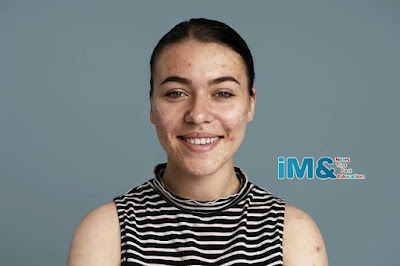Acne, a common skin condition, is not just limited to teenagers. Adults in their 20s, 30s, and even 40s can also experience the frustrations and embarrassment caused by acne. While not life-threatening, severe cases of acne can lead to permanent scarring, affecting one's self-esteem and confidence. But have you ever wondered why acne occurs in the first place?
Acne begins when the hair follicle duct becomes blocked, resulting in the formation of a plug. This plug is caused by a combination of factors, including increased skin cell turnover, excessive production of sebum (oil), and the deposition of keratin, a protein.
The presence of a specific bacterium called p.acnes further exacerbates the situation by releasing inflammatory fatty acids, triggering the body's defense mechanisms and causing an inflamed spot.
But what leads to these changes in the skin? It all starts with a decrease in the levels of linoleic acid, a vital component in maintaining healthy skin. This reduction in linoleic acid occurs due to a sensitivity to the hormone DHT, which is formed from testosterone. The conversion of testosterone to DHT is facilitated by an enzyme called 5-alpha reductase.
Now that we understand the underlying causes of acne, let's explore some possible solutions:
- Hormonal fluctuations cannot be completely stopped, but some individuals attempt to regulate them through various means, such as taking plant hormones or hormone replacement therapy (HRT). However, interfering with the body's natural hormonal balance may not be the best approach.
- Roaccutane, a medication that affects the conversion of testosterone to DHT, can be used to treat acne. However, it may lead to side effects since DHT plays a role in multiple bodily functions.
- A targeted approach involves reducing DHT levels in the pilo-sebaceous unit, the area where acne occurs, without affecting DHT conversion in other parts of the body. Specialized products containing tri-ethyl citrate and ethyl linoleate can alter the conditions in the skin, slowing down the enzyme 5-alpha reductase and reducing DHT levels locally.
- Replenishing linoleic acid levels in the skin can help regulate oil production and prevent the formation of plugs and the colonization of p.acnes. While oral supplementation with linoleic acid may require high and potentially toxic doses, topical preparations could provide a more effective and safer solution.
- Eskimos, or the Inuit, traditionally had low rates of acne until the introduction of Western diets. This observation suggests that dietary changes, specifically an increase in linoleic acid intake, can impact the acne process. Finding ways to supplement skin linoleic acid levels through topical preparations could be a promising avenue for acne treatment.
- Incorporating special delivery technology, such as Oleosomes and Drysyst technology, into creams can enhance the penetration of linoleic acid into the skin. Additionally, products containing ethyl linoleate can utilize skin bacteria to release linoleic acid, further benefiting acne-prone skin.
- Normalizing skin cell turnover and reducing skin thickening can prevent the blockage of hair follicle ducts. Retinol A-based creams, although they increase sensitivity to UV and carry potential risks, have shown effectiveness in normalizing skin cell turnover rates. Triethyl citrate is another chemical that normalizes keratin deposition and skin cell turnover rates without causing photosensitivity.
- Controlling oil levels on the skin is crucial, but using harsh detergents can lead to a negative feedback loop, triggering increased sebum production. Mild detergents, combined with triethyl citrate and ethyl linoleate, have been proven effective in reducing sebum production rates.
- Exfoliants and detergents can aid in unblocking ducts by dissolving and removing plugs and minimizing skin debris. Chemical exfoliants like salicylic acid and pyruvic acid have shown sebo-static effects, temporarily slowing oil production. It's important to choose products that won't irritate the skin or exacerbate inflammation.
- Gentle cleansing agents containing silicone and glucose-based cleansers can be suitable alternatives for sensitive or younger skin types. These cleansers, combined with triethyl citrate, help address skin thickening and overactive skin cell turnover.
- To control the growth of p.acnes without attacking beneficial skin bacteria, it's essential to change the conditions in the pilosebaceous unit. Antibiotics may be useful in certain cases, but there are risks associated with the development of antibiotic-resistant bacteria. Managing the enzymes released by p.acnes, which break down plugs and release fatty acids, can help reduce inflammation and hinder the growth of the bacterium.
- Finally, reducing inflammation is crucial in treating acne. Products that control bacteria and inflammation, along with antioxidants like skin-soluble vitamin C, can effectively combat acne-causing inflammation. Antioxidants help neutralize inflammatory free radicals and promote healthier skin.
Understanding the causes of acne and exploring innovative solutions allows us to approach acne treatment from a unique perspective. By addressing the underlying factors and using targeted approaches, we can revolutionize the way we combat acne and provide effective solutions for those affected by this common skin condition.
Follow iMand News on Google News

